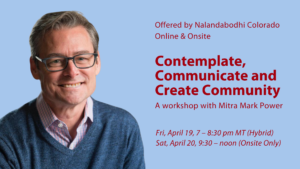 What does it really mean to be a Buddhist? How can we take what we learn by studying the teachings of the Buddha, and what we experience in our meditation practice — and put it to work in our lives, moment by moment. When we think of being a “Buddhist” and following the Buddha’s teachings, what do we think that means? It’s probably common to think first, “Well, I sit on a cushion and meditate.” Second, we might think, “I go to hear Buddhist teachers, I read books, and I go to some classes.” While meditation practice and study are important, what about the rest of life? We might cover that by saying, “I try to be more kind and pay attention to what I do.” We might think that our meditation and study will take care of the life part, that these honorable endeavors alone will lead to a transformation of our suffering into happiness and our mental confusions into Buddha-like wakefulness. But is that how it really works? If you’ve been around the Buddhist scene for any length of time, can you verify that?
What does it really mean to be a Buddhist? How can we take what we learn by studying the teachings of the Buddha, and what we experience in our meditation practice — and put it to work in our lives, moment by moment. When we think of being a “Buddhist” and following the Buddha’s teachings, what do we think that means? It’s probably common to think first, “Well, I sit on a cushion and meditate.” Second, we might think, “I go to hear Buddhist teachers, I read books, and I go to some classes.” While meditation practice and study are important, what about the rest of life? We might cover that by saying, “I try to be more kind and pay attention to what I do.” We might think that our meditation and study will take care of the life part, that these honorable endeavors alone will lead to a transformation of our suffering into happiness and our mental confusions into Buddha-like wakefulness. But is that how it really works? If you’ve been around the Buddhist scene for any length of time, can you verify that?
As wonderful and powerful as these activities are, there’s something missing when we think that our Buddhist path is made up of just meditation and learning theories and philosophy.
To really wake up, to get out from under our suffering, to get to the point of feeling free and actually enjoying our life, the Buddha taught a third method. You can call it a path in itself, “the path of activity.”
It’s about how we engage with our life altogether. We may sit on a cushion for thirty minutes with a clear intention to wake up, but what’s our intention for the remaining 23.5 hours or for the thousand things we do every day? To make “activity” a genuine part of our spiritual practice means to bring the understanding and insight we get from meditation and study into our day-to-day life, into our awareness of each moment. In other words, we have to APPLY what we know. We have to see that our actions have effects and then learn to work with our actions to achieve the effects, like happiness, that we want. If we don’t, then nothing changes, and we wonder why. This life isn’t an exercise we can come back to later. Our life is where the “wheel of action” turns and whole thing plays out. It’s where the rubber hits the road and we get to see the actual condition of our practice.
 Mitra Mark Power is a certified Buddhist chaplain who has been a key leader in Nalandabodhi since its inception. He has studied intensively with Vajrayana teachers in the West for more than thirty years and calls on this experience to impart the Buddhist instructions for bringing wisdom and compassion into daily life.
Mitra Mark Power is a certified Buddhist chaplain who has been a key leader in Nalandabodhi since its inception. He has studied intensively with Vajrayana teachers in the West for more than thirty years and calls on this experience to impart the Buddhist instructions for bringing wisdom and compassion into daily life.





